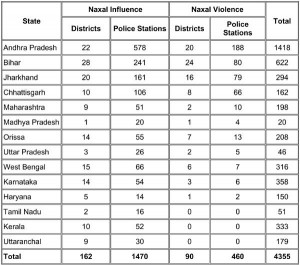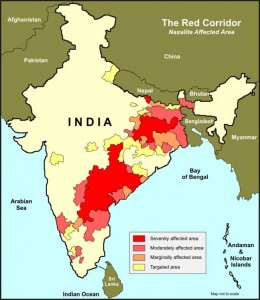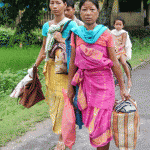Naxalites owing allegiance to the Communist Party of India (Maoist) have been waging a bloody insurrection against the Indian state with the ultimate objective of capturing political power through protracted armed struggle and area-wise seizure of power. As an outfit, the CPI (Maoist) is a little over two years’ old. But, its constituents – the erstwhile Communist Party of India – Marxist-Leninist (People’s War) [CPI-ML (PW)] and the Maoist Communist Centre of India [MCCI] have been in operation for well over two decades, until they merged on September 21, 2004 to float the new outfit, CPI (Maoist), which is incontrovertibly the most lethal Naxalite group in the country and, arguably, one of the most dreaded extremist outfits in India.
Unlike what the MHA wants us to believe, the Maoists are neither getting weak, nor are their capabilities waning”¦
According to official sources, the influence of the Naxalites exists in 162 districts across 14 States in varying degrees. Further, there have been reports to suggest the Maoists are making fervent attempts to penetrate the industrial towns of Gujarat, parts of Haryana and Punjab, as well as entrusted a member of the apex and ‘all-powerful’ Central Committee, to mobilise supporters in Assam. Table below presents a state-wise break-up of districts and police stations hit by Naxalite influence and violence.
On the other hand, in its public statements the Union Ministry of Home Affairs (MHA) is, apparently, underplaying the spread and influence that the Maoists currently enjoy. Besides, its three top-functionaries – the Home Minister, Minister of State and Home Secretary – have, from time to time, given conflicting and, perhaps, incorrect information on the intensity of Maoist presence and influence.
Also read: Police cannot take on Maoists
The MHA’s Annual Report 2005-06, and the March 13, 2006-Status Paper on the Naxal Problem held that 509 police stations countrywide were affected by Naxalism. But, Andhra Chief Minister, YS Rajasekhara Reddy revealed during the Chief Ministers’ Conference on Internal Security on September 5, that 500 police stations were affected in his state alone.
 Earlier, Minister of State Home Affairs Sriprakash Jaiswal said in reply to Question No. 1890 in the Lok Sabha, on March 15 2005: “… 126 districts in 12 states are affected by Naxal violence/influence in varying degrees”. He went to add, “Out of these, 76 districts in 9 states are badly affected.” Contradicting his colleague, Home Minister Shivraj Patil said: “I have personally collected data… only 50 districts are affected”, while speaking in the Lok Sabha on May 22, 2006.
Earlier, Minister of State Home Affairs Sriprakash Jaiswal said in reply to Question No. 1890 in the Lok Sabha, on March 15 2005: “… 126 districts in 12 states are affected by Naxal violence/influence in varying degrees”. He went to add, “Out of these, 76 districts in 9 states are badly affected.” Contradicting his colleague, Home Minister Shivraj Patil said: “I have personally collected data… only 50 districts are affected”, while speaking in the Lok Sabha on May 22, 2006.
On the other hand, Union Home Secretary VK Duggal has an entirely different view. Addressing the media and probationers at the National Police Academy, Hyderabad, on July 3, Duggal claimed that Naxalite activity was noticed in merely “6.5 states to be precise.”
However, on April 13, the Prime Minister said during the second conference of the Standing Committee of Chief Ministers of Naxalite-affected States that the Naxalite movement “has now spread to over-160 districts”.
The most worrisome aspect of the rising tide of Naxalism is the increasing militarisation of cadres of the CPI (Maoist).
Unlike what the MHA wants us to believe, the Maoists are neither getting weak, nor are their capabilities waning. The cadre strength of the Naxalites, too, has steadily been on the rise, over the past few years. According to Annual Report, 2005-2006 of the MHA, it is estimated that the armed-underground cadre strength of the CPI-Maoist is over 9,300 men and women, holding some 6,500 regular weapons and a large number of country-made arms. Quoting MHA officials, a media report of October 2005 held that the total underground strength of the Naxalites in 2003 was over-6,300, while it rose to over-7,100 in 2004. In the absence of authentic data it is difficult to estimate the present underground strength of the Naxalites, but it may not be wrong to suggest that it could be approximately 10,000 cadres.
Also, fatalities in Naxalite-related violence, too, have been fairly high. The MHA stated in its Annual Report, 2005-2006 that, in 2002 the number of fatalities (civilians, security force personnel and Naxalites) stood at 623, while the figure rose to 721 in 2003. The Annual Report also noted that a total of 623 lives have been lost in Naxalite-related violence in 2004; if the now-failed peace process was not held in Andhra Pradesh for the greater part of 2004, arguably, fatalities would have been higher during that year. The total number of fatalities in 2005 increased substantially over the previous year and stood at 892. In 2006, according to provisional figures provided by the authoritative South Asia Terrorism Portal (www.satp.org) of the Institute for Conflict Management, as on November 12, 2006, a total of 677 lives have been lost in Naxalite violence countrywide (259 civilians, 107 security force personnel and 311 Naxalites).
Also read: Blueprint to tackle the Maoists
The most worrisome aspect of the rising tide of Naxalism is the increasing militarisation of cadres of the CPI (Maoist). This increasing militarisation can be seen both in the phenomenal increase in fire-power of the Maoists, as well as the lethality of attacks, and the very character of the attacks themselves. At the initiation of their insurgency in the 1970s the Naxalites used traditional weapons such as farm implements and later crude bombs. Now, the Maoist arsenal boasts of a wide variety of weapons, both country-made and sophisticated. These include country-made guns, SBBLs, DBBLs, SLRs, AK series rifles, and INSAS rifles.
The Maoists always ““ and in all States ““ had the initiative on their side, while each of the States has invariably been reactive.
Importantly, the Maoists have added “crude rocket launchers” to their arsenal in recent times. In a very significant raid, the police in Andhra Pradesh recovered over 800 empty shells of rockets and a few launchers in early September 2006. Subsequent investigations led the trail to the Ambattur industrial suburb in Chennai. In the investigations, it later emerged that the Maoists planned the development and fabrication of rockets and launchers in two phases. Each was deemed as a project and was termed “Rocket Launchers – I and “Rocket Launchers – II”.
It would be instructive to take a look at the meticulous and systematic planning that went into the course of the development of rockets by the Maoists. The first was a “pilot project” that was conducted earlier to May 2004. In that phase, the Maoists are believed to have manufactured 25 rockets as well as a few launchers at a cost of Rs 950 per piece of rocket. While 15 rockets were distributed to armed squads operating in different parts of Andhra Pradesh, five more were tested at Burugundala, while the remaining five were set aside for further trials and improvement. A small but technically well versed group of senior leaders belonging supervised the tests and suggested improvements.
In the second phase of rocket development, which was code-named “Rocket Launcher – II”, the Maoists attempted to develop shoulder-fired rockets and rocket launchers. It is believed that these were tested sometime in early October 2006. Still novices at developing these rockets and being very cautious, the Maoists test-fired them by tying them to a tree in order to learn their accuracy, lethal effect and their range. In the tests it was realised that the rockets were “not effective enough”, but had tremendous “nuisance value”.
It was at this stage, a senior Central Committee member instructed “Tech Madhu” the lynchpin in getting the rockets fabricated in Ambattur to manufacture 1600 Rockets and 40 Rocket Launchers. While a vast majority of these were recovered during the September 2006-raids, at least 400 rockets are said to have reached the Maoists deep inside the jungles and have been safely tucked away in arms dumps. According to the Maoists themselves, they have been using the rockets as an area weapon rather than as target weapon. In fact, these 1,600 rockers and launchers were manufactured at an approximate cost of Rs. 35 lakh.
“¦ there is no unanimity in the perception of the various affected States on the Naxalite issue.
A critical aspect of the increasing militarisation of the Maoists is repeated attacks since 2004 involving large numbers of a few hundred hard-core, well-trained cadres and activists. Until now, on five different occasions the rebels have launched attacks involving a few hundreds and these were conducted in a synchronised and well-coordinated fashion, attacking multiple targets within a given area. Such attacks include:
- February 6, 2004: A few hundred Naxalites laid siege to the district headquarters town of Koraput, Orissa, brought it to a complete halt for a few hours, attacked the district headquarters complex, made an abortive attempt to storm the jail, but successfully raided the district armoury looting all 500 weapons and several thousand rounds of ammunition.
- June 23, 2005: Over 200 Maoists went on a rampage in Madhuban, East Champaran district, Bihar. They looted many arms, set a police station on fire, killed three policemen, attacked the Block Office looting arms and killing two guards, and looted two banks.
- November 11, 2006: Armed Maoists and members of the people’s militia numbering a few hundred raided the Home Guards Training Center in Giridh, Jharkhand, and looted 185 rifles and 25,000 rounds of ammunition.
- March 24, 2006: A few hundred Maoist rebels and people’s militia members launched a raid on Ramagiri Udaygiri (R Udaygiri) town of Gajapati district, Orissa.
A critical aspect of the increasing militarisation of the Maoists is repeated attacks since 2004 involving large numbers of a few hundred hard-core, well-trained cadres and activists
Among the attacks, thus far, involving a few hundred armed, well-trained guerrillas and people’s militia members, the November, 13, 2005 Jehanabad Raid, which the Maoists refer to as Operation Jail Break, is the most remarkable striking. During the raid the rebels conducted synchronised attacks on the district jail, district court, police lines, police quarters, district armoury, and police stations. The Maoists looted several hundred rifles and a huge quantity of ammunition. The focus of the raid was on the district jail and the Maoists set free 341 prisoners, including prominent Maoist leader Ajay Kanu, and a few other Maoist cadres. Also, the rebels abducted an unspecified number of their class/caste enemies belonging to the Ranveer Sena and later executed at least nine of them.
The Jehanabad raid acquires significance for two important reasons. In terms of the numbers involved in the raid, it is the largest-ever staged by the Naxalites in the country. Besides, among the approximately 1,000 people who reportedly conducted the raid, an overwhelming number of common people, who the Maoists would term as members of the ‘people’s militia’, were involved, along with battle-hardened underground cadres. It, thus, becomes abundantly clear that in some pockets that are under the sway of the Maoists, they have created and trained the third and crucial component of their military wing – the people’s militia or ‘base force’; the other two components are military platoons which constitute the ‘primary force’ and guerrilla squads which form the ‘secondary force’. In fact, that there is in operation a people’s militia is a clear pointer to the intensity of support that the rebels have come to wield in the areas under their control.
 Moreover, the Jehanabad raid has been an immense morale booster for the Maoists and they might, thus, plan to launch more similar attacks in future. ‘Moreover, it might, perhaps, not be difficult to imagine, and be prepared for, the psychological impact it would create if the rebels were to launch attacks of such magnitude simultaneously at, hypothetically, five or six different places spread across the country.’
Moreover, the Jehanabad raid has been an immense morale booster for the Maoists and they might, thus, plan to launch more similar attacks in future. ‘Moreover, it might, perhaps, not be difficult to imagine, and be prepared for, the psychological impact it would create if the rebels were to launch attacks of such magnitude simultaneously at, hypothetically, five or six different places spread across the country.’
On the other hand, the Union Government and the various affected States are yet to display any sense of urgency and effective ground-level action to contain the Maoists and defeat their designs. On their part, the affected States have just about submitted their action plans involving “security and development” measures that they would implement in their respective States. In fact, the Maoists always – and in all States – had the initiative on their side, while each of the States has invariably been reactive.
As one well-known analyst of the Naxalite movement in India pointed: ‘any action, thus far, by all the affected States has been limited to militarily fighting the Naxalites, while, unfortunately, measures and programmes in the socio-economic planes have been almost near totally absent.’ At the same time, it would also be useful to bear in mind that, at the all-India level, even in militarily curbing the Naxalites, the success has not been noteworthy; except in Andhra Pradesh, which has a well-trained and dedicated anti-Naxalite force known as Greyhounds, and an excellent intelligence network.
“¦on five different occasions the rebels have launched attacks involving a few hundreds and these were conducted in a synchronised and well-coordinated fashion, attacking multiple targets within a given area.
Besides, there is no unanimity in the perception of the various affected States on the Naxalite issue. Thus, while States such as Chhattisgarh and Tamil Nadu have proscribed the CPI (Maoist), West Bengal has refused to do the same. Orissa has lately banned the CPI (Maoist), while Karnataka issued contradictory statements and finally chose not to ban the organisation. On its part, Andhra Pradesh allowed the ban to lapse, initiated a peace process and reimposed proscription in August 2005, in the wake of the assassination of a Ruling party MLA. It is also pertinent that except for the CPI (Maoist) no other Naxalite group in the country has been proscribed in any of the states or by the Centre, even though some of them are committed to protracted armed struggle.
On its part, after vacillating and taking diametrically opposite stands on its role in dealing with the Naxalites, the ruling United Progressive Alliance (UPA) government at the Centre finally announced a 14-point policy on March 13, 2003 and, thus, the Union Home Minister sprang a surprise on Parliament. The framing of the policy is shrouded in mystery. Moreover, there is no information on the quality of inputs that were taken while framing the policy. One is not aware if the Government considered the recommendations of the Ruling Congress-I appointed “Task Force on Naxalite Violence”, which was headed by former Minister and senior Andhra Pradesh Legislator M. Shashidhar Reddy. It is also not known if the affected states were consulted and whether the Status Paper had the approval of the Cabinet. Moreover, speaking in the Chhattisgarh capital Raipur, earlier during the very same day (March 13) that the policy was announced in Parliament, Chief Minister Raman Singh said there was “confusion” in the policy response to the Naxalite threat and there was little or no coordination among the affected states. Repeatedly, on several occasions in the past, he had called for a national policy on the Naxalite problem.
The Jehanabad raid acquires significance for two important reasons. In terms of the numbers involved in the raid, it is the largest-ever staged by the Naxalites in the country.
Some of the aspects of the Centre’s policy are marked by obvious contradictions and confusion. For example, Point V of the policy says: “There will be no peace dialogue by the affected states with the Naxal groups unless the latter agree to give up violence and arms.” However, speaking on September 19, 2005, on the sidelines of the Conference of Chief Ministers of Naxalite-affected states, the Union Home Minister said: “If they drop arms, it is good. But if they want to carry arms and still talk… we don’t have any difficulty. We are not afraid to do so.” Perhaps it was in line with such thinking that the Andhra Pradesh government implemented a peace process with the CPI-Maoist and the Janasakthi, allowed them to bear arms brazenly, and sat at the negotiating table with them on October 15-18, 2004.
Even after this policy was announced there is little evidence to indicate that things are actually moving on the ground. The Union Home Ministry recently formed an Anti-Naxalite Cell and it is yet to take full shape. The cell was formed reportedly because the hitherto existing structure – a Joint Task Force headed by Special Secretary (Home), a Coordination Centre chaired by the Home Secretary and a Standing Committee of Chief Ministers presided over by the Home Minister – has not been effective enough to tackle the Naxalites. It has also been reported that an Empowered Group of Ministers (EGoM) would be constituted to coordinate between the various ministries that are connected with addressing the Naxalite issue in a comprehensive manner.
Thus, while the Union Government and the various affected States are yet to evolve a comprehensive, multi-dimensional response to the Naxalite issue, it is difficult to suggest that the spatial spread, influence and activities of the Maoists, as well as violence in Naxalite-related incidents, would reduce in the immediate to near future.




